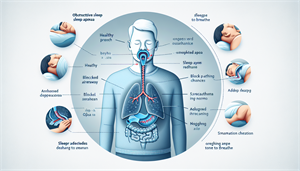
Unveiling Obstructive Sleep Apnea (OSA)
To demystify Obstructive Sleep Apnea (OSA), one must first comprehend its nature. OSA is a common sleep disorder that involves repeated interruptions in breathing during sleep, caused by a full or partial collapse of the upper airway. Obstructive sleep apnea occurs when the obstruction of the upper airway can be due to a negative collapsing pressure during inspiration. This can be worsened by the progressive narrowing during expiration in the retro palatal area. OSA has significant implications for cardiovascular health, mental well-being, and quality of life. It also affects driving safety, making it more than just a nighttime nuisance. Distinguishing OSA from other sleep disorders is crucial as it is often mistaken for central sleep apnea, a different type of sleep apnea which occurs when the brain fails to send proper signals to the muscles that control breathing, rather than an obstruction in the airway. Knowing the difference is key, as while both disorders disrupt sleep, the causes and treatments vary.
Defining the Sleep Disorder
OSA occurs when throat muscles relax during sleep, narrowing or blocking the airway, which results in disrupted breathing and sleep disruption. The relaxation of these throat muscles can result in the narrowing or complete blockage of the airway, leading to the interruption of normal breathing and the onset of OSA. It’s like trying to drink a thick milkshake through a narrow straw; you might get some through, but it’s a struggle. Interestingly, anatomical and neuromuscular factors contribute to the airway obstruction observed in OSA, which makes it a complex disorder to manage. The result is a series of complete or partial airway collapses during sleep, leading to reduced or halted airflow, resulting in lowered oxygen levels and disturbed sleep patterns. This struggle for air while you’re sleeping can lead to daytime symptoms such as excessive daytime sleepiness, morning headaches, and dry mouth upon waking.
Frequency and Severity
Far from a solitary condition, OSA impacts nearly 1 billion adults aged 30–69 years globally. (source) In the United States alone, about 2% of children and an estimated 25-30% of men and 9-17% of women meet the criteria for OSA. However, what’s alarming is that up to 90% of individuals with OSA are unaware of their condition. That’s like walking around with a ticking time bomb and not knowing it!


